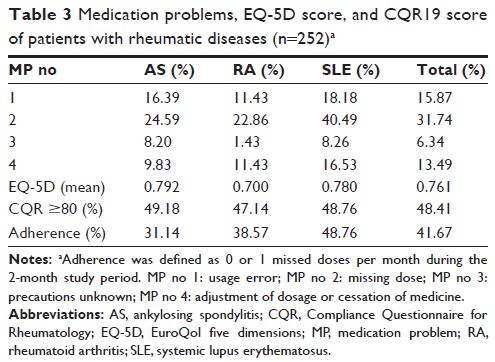9 7 8 1 6
论文已发表
注册即可获取德孚的最新动态
IF 收录期刊
- 3.3 Breast Cancer (Dove Med Press)
- 3.4 Clin Epidemiol
- 2.5 Cancer Manag Res
- 2.9 Infect Drug Resist
- 3.5 Clin Interv Aging
- 4.7 Drug Des Dev Ther
- 2.7 Int J Chronic Obstr
- 6.6 Int J Nanomed
- 2.5 Int J Women's Health
- 2.5 Neuropsych Dis Treat
- 2.7 OncoTargets Ther
- 2.0 Patient Prefer Adher
- 2.3 Ther Clin Risk Manag
- 2.5 J Pain Res
- 2.8 Diabet Metab Synd Ob
- 2.8 Psychol Res Behav Ma
- 3.0 Nat Sci Sleep
- 1.8 Pharmgenomics Pers Med
- 2.7 Risk Manag Healthc Policy
- 4.2 J Inflamm Res
- 2.1 Int J Gen Med
- 4.2 J Hepatocell Carcinoma
- 3.7 J Asthma Allergy
- 1.9 Clin Cosmet Investig Dermatol
- 2.7 J Multidiscip Healthc

在中国上海的一个大型风湿病中心的风湿疾病门诊患者的治疗依从性和疾病负担
Authors Zhang L, Lu GH, Ye S, Wu B, Shen Y, Li T
Received 22 June 2017
Accepted for publication 28 August 2017
Published 18 September 2017 Volume 2017:11 Pages 1591—1601
DOI https://doi.org/10.2147/PPA.S144624
Checked for plagiarism Yes
Review by Single-blind
Peer reviewers approved by Dr Amy Norman
Peer reviewer comments 2
Editor who approved publication: Dr Naifeng Liu
Purpose: The purpose of this study was to determine treatment adherence and
disease burden, analyze detailed medication problems experienced by patients,
and identify factors associated with adherence in patients with rheumatic
diseases in China.
Patients and methods: Patients with confirmed diagnoses of ankylosing
spondylitis (AS), rheumatoid arthritis (RA), and systemic lupus erythematosus
(SLE) were recruited, regardless of demographics, disease severity, and
treatment characteristics. Adherence was assessed using the Compliance
Questionnaire for Rheumatology and interview-based self-reports. A backwards-stepwise
multivariate regression analysis was used to identify factors associated with
adherence.
Results: We collected data on 252 patients who had a rheumatic
disease and visited our outpatient clinic in January or February of 2017. There
were 121 patients with SLE, 70 with RA, and 61 with AS. The overall adherence
rate was 41.7%, with 48.7% for SLE patients, 38.6% for RA patients, and 31.1%
for AS patients. The overall EuroQol (EQ)-index was 0.761; AS patients had the
best EQ-index (0.792), followed by those with SLE (0.780) and RA (0.700). SLE
patients also had greater annual direct costs (US$5,103.58) than RA or AS
patients.
Conclusion: Overall, 41.7% of our rheumatic disease patients
were adherent to treatment, lower than in many other parts of the world. This
indicates that it is important to identify methods that improve adherence in
this population. It is particularly important to improve the health status and
reduce the disease burden of patients with SLE, the most common of the three
rheumatic diseases we analyzed. Our results suggest that reminder tools may
improve adherence. Further prospective research is needed to confirm whether
reminder tools and other measures can improve patient compliance.
Keywords: adherence,
disease burden, EQ-5D, SLE, rheumatic disease
